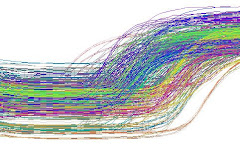Thursday, October 03, 2002
It must be Dispelling Eastern Philosophies Month at Nature Publishing Co.; after disproving out-of-body experiences two weeks ago, this week they published an article on Zen gardening, replacing centuries of Feng Shui with simple Graph Theory. The article is simple enough: researches at Kyoto University used computer modelling to study a Zen garden created 500 years ago, considered perfect by Zen masters. The researchers found that the various rocks positioned throughout the rectangular gravel bed created lines of symmetry between them that formed the shape of a tree. The irony being that for the past 500 years, people have been trying to explain the garden in terms of the rocks themselves; just as Feng Shui arranges rooms and buildings based on the items contained within. This has truly been an instance of not seeing the forest for the trees: the rocks and items are meaningless, except insofar as they define the spaces between them. While the Kyoto researchers interpret the lines as a tree - probably because of their own naturalistic biases - it is more accurate from the subconscious perspective to interpret them as paths. Our brains, like those of all vertebrates, evolved from simpler ganglia whose sole functions were to direct and coordinate locomotion. The simplest lamprey brains take in visual and olfactory cues and direct the muscles how to move to react to those cues. It is fundamental to our subconscious interpretation of the world to look for the paths between the obstacles. Western architects have known (some of them anyway) for years of the importance of not just spaces but the flow, or procession, through those spaces. The Zen garden is the ultimate example of procession: while we think it's showing us obstacles, it's really showing us the paths between them.
Subscribe to:
Post Comments (Atom)





No comments:
Post a Comment